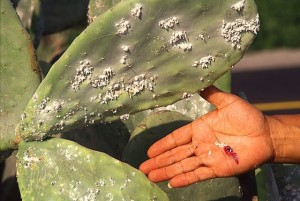Last week I noticed the spineless Opuntia cactus (nopales) had an infestation of scale insects. I crushed some in my hand and the result was a dark red stain and a quest that led south to the Aztecs, home to China and downtown to Santa Ana.

Cochineal insects on Opuntia cactus
The little insects were cochineal bugs, Dactylopius coccus; the stain was carminic acid, produced by the insect to protect itself from predation. That carminic acid has been used as a red pigment for at least 1500 years in central and South America. The compound was used to produce the pigment called “carmine lake,” a natural source for crimson color until chemists synthesized alizarin and related compounds beginning in the early 1900’s. The great downfall of carmine and most natural pigments is that they fade in bright light. Most modern synthesized pigments are light fast. The downfall of modern pigments is that they are carcinogenic, so bug-sourced cochineal is back in vogue, coloring your red velvet cupcake from Starbucks, your lipstick and pills and ointments.

El Greco’s El Salvador. The red in the robes is painted with cochineal.
Serendipity is a wonderful thing. Yesterday I saw an ad for a new show at the Bowers Museum in Santa Ana, “The Red that Colored the World.” The entire show deals with how cochineal has been used throughout history. By 1520 the Spanish invaders of the New World were profiting heavily form the cochineal trade. In fact, in 1523 Charles V decreased that no fabrics could be dyed in the Americas, but rather the dye must be shipped to Europe. And this resulted in the red dye trade to Europe and Asia. It was one of the most valuable commodities of the sixteenth and seventeenth centuries. It was used worldwide. The famed Florentine Medici family controlled a large part of the traffic. The red in the coats of the British soldiers was cochineal. Furniture from Napoleon’s château of Malmaison was upholstered in bright-crimson cochineal dyed wool. And it was incorporated into paints. Christ’s red silk tunic in El Greco’s The Salvador is painted in cochineal. Cochineal has been identified in the paintings of Canaletto, Delacroix, Rembrandt, Renoir, Van Gogh, Velázquez, and Van Dyck. When it reached China, the primary dye for red silk was derived from the root of the madder plant, think alizarin. Cochineal was a brighter crimson and quickly captured the attention of the emperors.
As a painter, I’m always thinking about color, but not usually about where it came from. In the Blick Art store I encountered some dry powdered pigments. I remember thinking, “Wow, I’m glad I don’t have to use those to make paint.” But those dry, powered pigments must have a source. The next time I’m there I’m going to look for carmine lake and give paint making a try.
The Red that Colored the World is open from October 31 through February 21, 2015 at the Bowers Museum, 2002 N. Main Street, Santa Ana, CA 92706
http://www.bowers.org/index.php/exhibitions/current-exhibitions/417-the-red-that-colored-the-world





 and juicy. It was introduced to Seed Savers Exchange in 1983 by Dorothy Beiswenger from Polk County, Minnesota. The best dish I can concoct in five minutes from my summer garden is a few slices of rainbow colored tomatoes interlaced with the first four tender leaves from fresh sweet basil, drizzled with olive oil, finished with a dash of ground pepper or diced chives. The explosion in your mouth is like a sip of fine aged wine; instantly I have the taste of the whole summer inside my mouth. Whoever said you couldn’t eat your inspiration?
and juicy. It was introduced to Seed Savers Exchange in 1983 by Dorothy Beiswenger from Polk County, Minnesota. The best dish I can concoct in five minutes from my summer garden is a few slices of rainbow colored tomatoes interlaced with the first four tender leaves from fresh sweet basil, drizzled with olive oil, finished with a dash of ground pepper or diced chives. The explosion in your mouth is like a sip of fine aged wine; instantly I have the taste of the whole summer inside my mouth. Whoever said you couldn’t eat your inspiration?